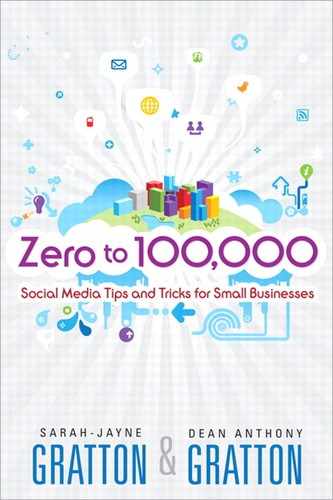8. Blogging Your Way to Business Success
This is the age of the blog! An age when even the President of the United States has seized the importance of this global phenomenon, appealing to those new-age bloggers among us to support his campaign values.1 But, blogging is actually nothing new. Ever since the first cavemen drew on walls, the need to document and share our thoughts and experiences in an attempt to make meaning of them has been a strong force within us.
Studies suggest that blogs are depended on more today for factual review than their traditional news counterparts.
Now, billions of journal entries later, we find ourselves using keyboards rather than quills and writing content using technology-integrated new media that has revolutionized the way we source and exchange information.
In Blogging We Trust
With this firmly in mind, we’re about to shed some light on what many in the traditional media regard as a bone of contention, primarily out of fear of losing their advertising revenue (and let’s face it, who can blame them?). There’s no doubt that today’s blogs pack an enormous amount of clout among their subscribers, and some studies suggest that blogs such as Mashable (Mashable.com) and The Huffington Post (Huffingtonpost.com) are becoming more trusted for factual review than their traditional news counterparts. Certainly, social media routes have taken precedence in terms of immediacy in reporting events; but now, more than ever, they have also become trusted allies in a crowded media-centric world.

So why exactly has this shift occurred so profoundly? Well, one train of thought points to the likeness factor (that is, the tendency for people to assume that random people on the Internet are like themselves). It makes sense as, when you strip away the physical vestiges of race, class, gender, and style, people seem more than willing to assume that others they meet online are fairly similar to themselves, and this in itself builds an immediate sense of trust and empathy. With this thought in mind, it seems that where advertisers have been going wrong all these years is in trying to “buy” the public’s trust, which never quite works and is only ever one wrong move away from disgrace. And you don’t always need to earn it either. It seems the big secret to gaining trust is to get people to believe that you share their perspective and understand their experiences.
Don’t make the mistake of turning your blog posts into blatant sales pitches. This method of marketing will deter readers from subscribing to your blog.
It’s not all cause for celebration, however, certainly in terms of business blogging, where, for the most part, we’re still getting it wrong. The research group Forrester2 found that of all blog content, people are inclined to believe corporate blogs the least; and when we consider the evidence, there’s an obvious reason for this. Corporate blogs are often written by a sales team in disguise, and like those traditional advertisers before them, they are using their blogs as a means to continually pitch their products to the public, a method of marketing that we know just doesn’t work anymore.
So how do you put together a business blog that will not only be taken seriously but be trusted and shared by its readers and even picked up on the wider net to bring in new subscribers? This chapter shows you how to construct and manage the perfect blog for your brand that attracts rather than repels and creates a buzz that brings about a greater awareness of your business and its related products and services.
Using Your Head and Your Resources
Choosing the right platform and foundations for your blog begins with some fundamental decisions based on both your blogging requirements and the resources that you may already have within your business. Several key checkpoints need to be considered when formulating a successful blogging mission statement:
• Determine posting frequency.
• Define how the blog should support the business.
• Understand your audience.
• Assign writers/researchers to be brand ambassadors.
• Set and follow word-count limits.
Each of these checkpoints is expanded on here.
How Often Should You Post?
First and foremost, you need to decide just how often you intend to post a new blog. “How on earth do I do that?” you ask. “What’s the magic formula for success?” we hear you cry. Well, there’s no definitive answer, and again, there’s no one-size fits all philosophy, so let’s start with some key issues.
What Do You Want to Gain from Your Blog?
Increasing your blog readership is a goal in itself, of course; but how should your blog work to support your overall business goals, and will it be a fundamental part of your marketing strategy? For example, if your website itself is a business generator, a good blog will provide it with additional credibility and references gained from reviews and accompanying stories and comments. The majority of people read a blog because they want to expand their knowledge about a particular subject or area of their lives in a way that will add value. Knowledge is a powerful personal currency and one that most of us have a need to build through expanding our understanding of those things that have a positive effect upon us. What we as businesses and brands ultimately need to gain from our blogging endeavors is our own post power stream; one that provides added value for our readers and positions us as authorities within our particular sectors. Our editorial foundations for this will be found through careful analysis of what our audience requires, in particular those aspects of our business or brand that might be questioned or misunderstood. Wherever possible, we need to provide answers to the most common questions in a way that delivers fresh, engaging, and valuable insights to create a continual buzz and generate an active following.
Who Is Your Audience?
By now, you should already know the answer to this question. The process behind setting up your other key social media platforms should have firmly cemented it into your psyche. Now it’s time to re(de)fine your audience in terms of blog appeal. How much time do you suppose most of them will have to read blogs, and how active are they themselves in the blogging arena? What times of the day are they most likely to sit and read your blog? Remember that building a successful blog is like establishing a new community based on common interests and values. Instilling this sense of community among your subscribers will help to ensure its popularity and long-term appeal. Chapter 14, “Step 5: Instilling a Sense of Community,” expands on this key point and helps you gain a further understanding about what can be achieved simply through the effective use of social media.
Who Are Your Brand Ambassadors?
Group blogs dramatically reduce the likelihood of burnout and are a great way for various members of your staff to become brand ambassadors, injecting their personalities into the posts and making them sparkle with team spirit. Identify those persons in your business who have a gift for communication and give their writing the chance to shine through your blog. Their individual personalities should be tailored to specific areas of the blog, based upon areas of expertise, so that they blend into one harmonious blogging symphony that will both inform and generate a response from your subscribers. Think of sectioning of your blog in the same way that you would segment a newspaper or magazine and allocate specific topics to the same brand ambassadors’ post after post to maintain consistency in writing style and blog personality.

Size Isn’t Everything, Is It?
Think about the most memorable blogs you’ve read. Revisit them and note their word counts. You’ll probably notice a common thread: Less is definitely more in the realm of the successful blog. With this in mind, remember to keep your blog posts concise and relevant without rambling or straying from your core message. It’s tough to engage busy people, and interest can be quickly lost when your word count goes beyond 500. This means that a certain amount of post tailoring is always required, but it’s a skill quickly mastered and full of rewards in terms of subscribers and reposts.

Moving Forward
Now that you have your blogging team in place, you can move forward and begin planning your initial and subsequent blogs.
Design and Platform
Looks are important! A clean and professional look for your blog will entice a potential subscriber to read on. If your budget allows, by all means employ the services of a professional designer to ensure that your blog has the best possible layout and design. If you already use a web designer, talk to him or her about tying in the look and feel of your blog to your site design.
If your budget won’t stretch to using a professional company to design your blog, the next best option is to use one of the low-cost or free theme templates that are available from popular blogging platforms such as WordPress (Wordpress.com), Tumblr (Tumblr.com), Blogger (Blogger.com), Posterous (Posterous.com), and TypePad (Typepad.com), as shown in Figure 8-1.
Figure 8-1. TypePad takes you step-by-step through the process of selecting and customizing a template, making it easy for first-time bloggers.
(Source: Typepad.com)
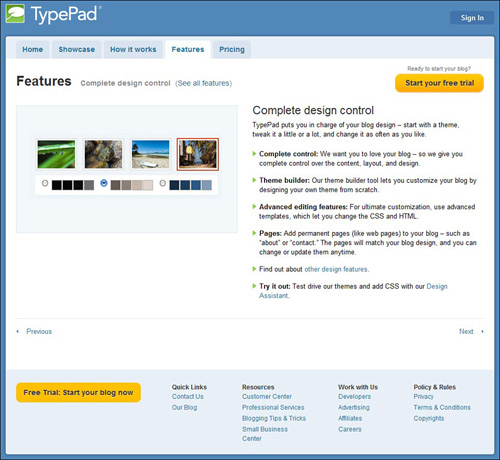
All of these platforms are designed to make life easier for bloggers and take you step-by-step through the process of launching your blog. Each platform has its own quirks and advantages, so the best advice is to check them all out and make a decision that best suits your business needs.
After signing up to your chosen platform, you’ll have a gallery of ready-made templates to select a design from (see Figure 8-2). Pick a color scheme and layout that ties in (wherever possible) with your logo and company message. Compare the different options available and see how well they tie-in with your business personality as @grattongirl did. Her blog reflects her unique personal brand, as shown in Figure 8-3. The predefined layouts can all be easily personalized, and all the platforms mentioned in this chapter provide step-by-step guides to painlessly customize your blog.
Figure 8-2. Try out a variety of themes to see which style fits best with your business message.
(Source: Onebuckebook.com)
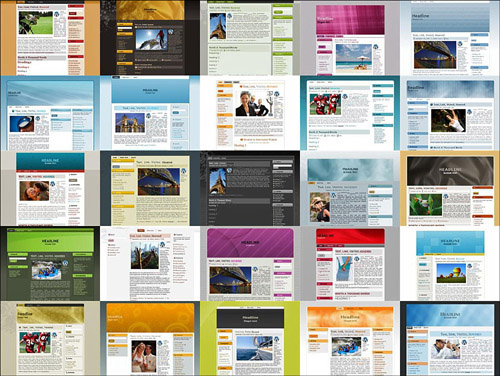
Figure 8-3. The @grattongirl blog ties in the profile message of Sarah-Jayne so that her followers and readers will instantly recognize her.
(Source: grattongirl.wordpress.com)
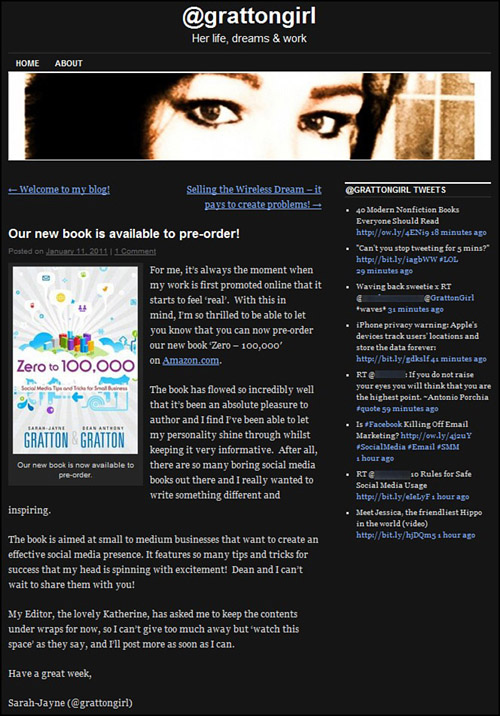
Content Planning
Work with your blog team to create an editorial calendar for your blog posts. Use it as a guide to ensure that your blogs are written on time and are fresh and relevant to your forthcoming products and promotions, but keep it flexible, as industry news and product/service revisions can change as time goes by. For example, blog posts surrounding the launch of a new product or service could be scheduled before, during, and after the event to cover the build-up, launch itself, and feedback following its release.
The Editorial Process
The editorial process can either be an elaborate or very simple affair, according to the size and scope of your business. A small business owner, for example, might follow this checklist to successfully plan content for his or her blog:
1. Brainstorm a list of content to publish.
2. Define dates and times when posts will be published.
3. Write each post in accordance with the publication schedule.
4. Edit and publish each piece.
A larger, corporate web team might have a more complex and flexible blog publishing process, like this:
1. Brainstorm a list of content to publish. Specify where and when the content should be published for a set time period. Include backup content items for each item set for publication and specify breakpoints to determine whether to delay or kill any content item.
2. Assign each piece of content based on the editorial calendar. Applications such as Google Calendar (see Figure 8.4) make it easy for group editing and approvals.
Figure 8-4. Google Calendar offers an effective way to produce an editorial calendar for your blog that can easily be shared and amended.
(Source: Google.com)
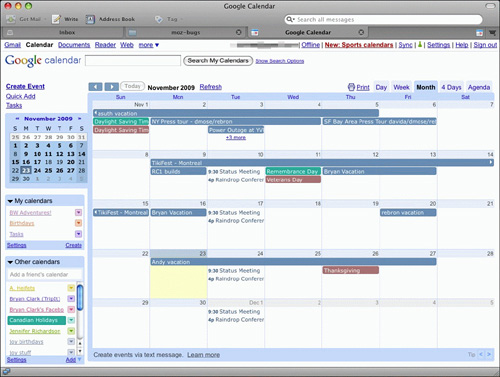
3. Produce each piece of content in accordance with the blog team assignment.

4. Review the first draft of each piece of content.
5. Give approval based on first draft edits (and adjust publication schedule if needed).
6. If approved, finish writing each piece of content and submit the draft.
7. Perform the final edit, copy edit, fact checking, and rewrites as needed.
8. Submit for review by legal team.
9. Make changes if/as needed based on legal input.
10. Submit content formally to your layout team (or blogging service).
11. Review content on the development server (published by blogging service or in-house team) and make changes if needed.
12. Publish the content on the production server.
Whatever the size of your company, a well-constructed production process will help you get the most out of your blog.
The Blog Post Process
After you’ve agreed on the best production process for your business size, it’s time to plan how each individual blog post will be created. You should also have a process in place to time manage and control each post. For example, an interview with a partnering company for a particular piece will require a number of initial emails in preparation, as well as time to refine any questions, interview your subjects, obtain clarifications, and write up the interview. This all needs to be allowed for in your editorial calendar.
Make time to document the different processes for each type of content you publish. For example, determine how much research is needed prior to writing, whether interviews are involved (which might incur time delays), and whether permissions are needed for photographs, logos, charts, and so on. Some types of blog post preparation have an identical process, but don’t assume they do. Sit down and map out the content-creation process to be 100% certain. This step alone will help avoid delays in your publishing schedule.
Sourcing and Building Great and Original Content
It’s important to keep your content fresh and relevant to your subscribers’ interests. The problem with many business blogs, however, is that they can easily become dry, stale, and repetitive. With this in mind, we’ve put together some simple exercises to help you and your blog team think creatively outside of the corporate box and make your posts really stand out and get noticed:
• Write a profile post on someone fundamental to your business.
• Select a popular blog post within your business arena (products/services) that you agree with and expand on the idea within it, linking to the original article and inviting comments.
• Find a popular blog post within your business arena that you disagree with and proactively deconstruct the idea, remembering again to link to the original.
• Find an iTunes podcast that relates to your business arena and write a review. Be sure to also post a link to your blog and brief summary of your review on iTunes as a way of thanking the creators of the podcast for their content.
• Ask a question relating to your business arena on Yahoo! Answers and document the responses in a blog post.
• Think of a how-to question related to your business and see whether it is answered in a YouTube video. Write about the question and embed the YouTube video within the blog. (We talk more about embedding videos later on in Chapter 9, “The Secrets to a Successful Blog.”)
• Write a blog composed of positive customer reviews of your services/products. Consider using scans of thank you letters, photos from users, and responses from company questionnaires as fillers.
• Create a company horoscope blog, using the start date of your company as its birthday. Read your company horoscope and use it as the basis of a blog to talk about your services, team, and any forthcoming events in a fresh and entertaining way.
